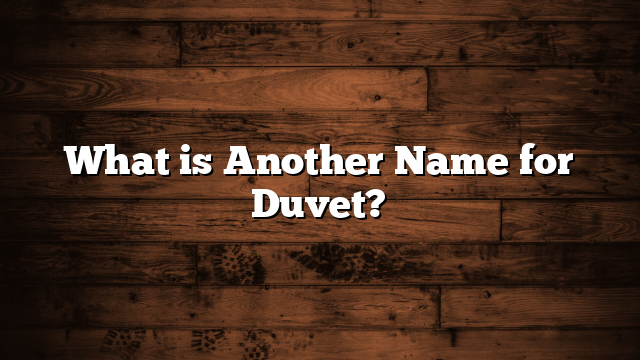A duvet is a type of bedding that is typically filled with down, feathers, wool, or a synthetic alternative. It is generally used as an insert inside a duvet cover, which helps keep the filling in place and provides protection for the duvet itself. Duvets are popular in Europe and are gradually gaining popularity in other parts of the world.
There are many different names for duvets, depending on where you live. In the United States, they are sometimes referred to as comforters or quilts. In Canada, they are commonly called doonas or continental quilts.
In the United Kingdom, Ireland, and Australia, they are simply called duvets. No matter what you call them, these cozy bedding items can add an extra layer of warmth and comfort to your bedroom.
A duvet is a type of bedding that is typically filled with down or feathers and used in place of a blankets and comforters. Duvets are popular in Europe and are gaining popularity in the United States. The term duvet comes from the French word for down, which is what the duvet is typically filled with.
Down is a type of insulation that comes from the undercoating of birds. It is light, fluffy, and provides excellent warmth without being too heavy. Feathers are another type of material that can be used to fill a duvet, although they are not as common as down.
DUVET BED MAKING "10 easy steps" (The California Roll Way) TESDA Housekeeping NC II Tutorial
Is a Duvet the Same As a Comforter?
A duvet is a type of bedding that is typically filled with down, feathers, wool, or a synthetic alternative. It is often used in place of a blanket or comforter. A duvet cover is also sometimes used to protect the duvet from getting soiled.
A comforter is a type of bedding that consists of two pieces: an inner fill layer and an outer fabric layer. The inner fill layer is usually made of down, feathers, cotton batting, or polyester fiberfill. The outer fabric layer can be made from many different materials, including cotton, polyester, microfiber, and even silk.
Comforters are typically softer and fluffier than blankets.
What is a Duvet British?
A duvet is a type of bedding that is typically filled with down, feathers, wool, or a synthetic alternative. It is often used in place of a comforter, blanket, or quilt. A duvet cover is also available to protect the duvet from getting dirty.
What is Another Word for a Duvet Cover?
A duvet cover is a protective layer that slips over a comforter, quilt or Duvet insert. It has a opening on one end that allows you to insert your comforter, and ties, buttons or an invisible zipper closure to keep it securely in place. A duvet cover can extend the life of your comforter by protecting it from body oils, makeup, sweat and other stains.
Plus, it’s easy to change up the look of your bedroom simply by switching out your duvet cover!
There really isn’t another word for “duvet cover” – in French, the word used is “couverture de lit” which translates directly to “bed cover”. In German, they use the word “Bettbezug” which means “bedding” or “bedclothes”.
So if you need another word for duvet cover, bedding or bedclothes will work just fine!
What is the Meaning of Duvet
A duvet is a type of bedding that consists of a quilted or padded cover, typically filled with down, feathers, wool, or synthetic fiber. The word “duvet” is derived from the French word for down (duvet), which refers to the soft undercoat of a bird. Duvets are often used in combination with sheets and blankets to create a layered look that can be easily changed with the seasons.
Conclusion
A duvet is a type of bedding that is typically filled with feathers, down, or a synthetic alternative. It is often used in place of a blanket and top sheet, as it can be removed and washed more easily. Duvets originated in Europe and are now popular worldwide.
The word “duvet” is of French origin and literally means “down.” Down is the soft undercoat of birds that keeps them warm. Duvets are usually made from this material, although some may also be filled with synthetic fibers.
